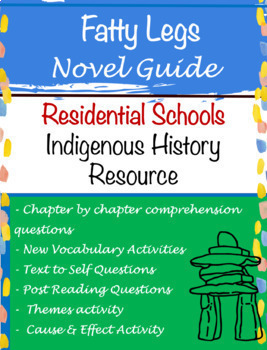Fatty Legs by Jordan - Fenton Residential Schools Novel Guide
The Art of Teaching Elementary
64 Followers
Grade Levels
4th - 7th
Resource Type
Standards
CCSSRL.K.1
CCSSRL.K.2
CCSSRL.K.3
CCSSCCRA.R.1
CCSSCCRA.R.2
Formats Included
- Google Slides™
Pages
70 pages
The Art of Teaching Elementary
64 Followers

Made for Google Drive™
This resource can be used by students on Google Drive or Google Classroom. To access this resource, you’ll need to allow TPT to add it to your Google Drive. See our FAQ and Privacy Policy for more information.
Description
Fatty Legs by Jordan-Fenton Novel Guide Indigenous History Residential Schools Canada The Orange Shirt Day teaching resource
This resource includes:
- Pre, During and Post Reading Activities
- Chapter-by-chapter Reading Comprehension Questions
- New Vocabulary
- Text to self questions
- Post Reading questions/reading workshop
- Cause & Effect Activity
- Themes Activity
- Character Analysis Activity
- Extension resources (Reading, Video & Map)
- Answer Key
This resource is great for:
- Teaching about Residential Schools
- Teaching Canadian History
- Teaching about First Nations Culture
- Social Studies centres
- Independent Work
- Distance learning, eLearning
- At home learning, homework
Similar Products:
***********************************************************************************************************
• Be sure to FOLLOW MY STORE for NEW PRODUCTS AND SALES >> click here
• Don't forget to leave feedback . You will receive TPT credits to be used towards future purchases!
Thank you,
Northern Classroom
Total Pages
70 pages
Answer Key
Included
Teaching Duration
1 month
Report this resource to TPT
Reported resources will be reviewed by our team. Report this resource to let us know if this resource violates TPT’s content guidelines.
Standards
to see state-specific standards (only available in the US).
CCSSRL.K.1
With prompting and support, ask and answer questions about key details in a text.
CCSSRL.K.2
With prompting and support, retell familiar stories, including key details.
CCSSRL.K.3
With prompting and support, identify characters, settings, and major events in a story.
CCSSCCRA.R.1
Read closely to determine what the text says explicitly and to make logical inferences from it; cite specific textual evidence when writing or speaking to support conclusions drawn from the text.
CCSSCCRA.R.2
Determine central ideas or themes of a text and analyze their development; summarize the key supporting details and ideas.



